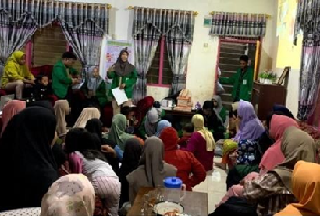Increasing maternal knowledge through counseling on the consumption of risky foods in children aged 2-10 years
Abstract
Nutritional status of thin, short, and fat that is high enough indicates food intake that is still unbalanced. Children's food intake is influenced by diet, when food supply, physical activity, and snack habits. One of the efforts to reduce the consumption of risky foods (instant snacks) is the implementation of the IEC program (communication, education, and information). The type of research used is observational with a descriptive approach and the sampling techniques used are simple random sampling and purposive sampling. The entire study population was mothers living in Bontona hamlet, Kanreapia village, Tombolo Pao District, Gowa Regency, totalling 32 respondents. In the implementation of the program, the results of increasing maternal knowledge were obtained after counselling activities on excessive consumption of risky foods (instant snacks) in children aged 2-10 years. Through this activity, it is hoped that mothers can practice the knowledge they have in parenting, especially the practice of providing nutritious food
References
Adetya, S., & Gina, F. (2022). Bermain origami untuk melatih keterampilan motorik halus anak usia dini. Altruis: Journal of Community Services, 3(2), 46-50.
Akubuilo, U. C., Iloh, K. K., Onu, J. U., Iloh, O. N., Ubesie, A. C., & Ikefuna, A. N. (2020). Nutritional status of primary school children: Association with intelligence quotient and academic performance. Clinical Nutrition ESPEN, 40, 208-213.
Chen, P. J., & Antonelli, M. (2020). Conceptual models of food choice: influential factors related to foods, individual differences, and society. Foods, 9(12), 1898.
Cohen Kadosh, K., Muhardi, L., Parikh, P., Basso, M., Jan Mohamed, H. J., Prawitasari, T., & Geurts, J. M. (2021). Nutritional support of neurodevelopment and cognitive function in infants and young children—an update and novel insights. Nutrients, 13(1), 199.
Fitria, F., & Sudiarti, T. (2021). Pengaruh Penyuluhan terhadap Peningkatan Pengetahuan Gizi dan Kesehatan pada Ibu Balita di Mampang, Depok. Jurnal Gizi Kerja Dan Produktivitas, 2(1), 9-14.
Garrido-Fernández, A., García-Padilla, F. M., Sánchez-Ramos, J. L., Gómez-Salgado, J., & Sosa-Cordobés, E. (2020). The family as an actor in high school students’ eating habits: A qualitative research study. Foods, 9(4), 419.
Indrawati, I., & Faridah, F. (2021). Pengetahuan dan Sikap Ibu dalam Pemberian Jajanan Sehat pada Anak di Taman Kanak–Kanak Baiturrahim Jambi. Jurnal Akademika Baiturrahim Jambi, 10(1), 215-225.
Khan, D. S. A., Das, J. K., Zareen, S., Lassi, Z. S., Salman, A., Raashid, M., & Bhutta, Z. A. (2022). Nutritional Status and Dietary Intake of School-Age Children and early adolescents: systematic review in a developing Country and Lessons for the global perspective. Frontiers in nutrition, 8, 739447.
Nurhayati, R., Utami, R. B., & Irawan, A. A. (2020). Health education about stunting nutrition in mothers to weight stunting children aged 2-5 years. Journal for Quality in Public Health, 4(1), 38-43.
Purwanti, R., Mufida, A. A., Dianingsih, A., S, A. V. T., Rachmawati, A., Azzahra, A. A., & Agustina, A. E. (2022). Program Tarik Sis! Terhadap Perubahan Perilaku Pemilihan Jajan dan Konsumsi Mie Instan pada Anak SDN 1 Lumansari Kendal. Proactive, 1(1), 1–7.
Puspita, I. D., & Ilm, I. M. (2021). Pelatihan Pemilihan dan Identifikasi Jajanan Sehat Anak. Jurnal Kreativitas dan Inovasi (Jurnal Kreanova), 1(2), 86–90.
Rod, N. H., Bengtsson, J., Budtz-Jørgensen, E., Clipet-Jensen, C., Taylor-Robinson, D., Andersen, A. M. N., & Rieckmann, A. (2020). Trajectories of childhood adversity and mortality in early adulthood: a population-based cohort study. The Lancet, 396(10249), 489-497.
Sari, F. Y. K., Khoiriyah, N., & Nuarita, D. A. W. (2021). Pola Konsumsi Balita Selama PPKM. Jurnal Medika Indonesia, 2(2)
Sari, Y., Febliza, A., & Sumandar, S. (2020). Peningkatan pengetahuan ibu-ibu tentang bahaya zat warna rhodamin B terhadap kesehatan anak usia sekolah di Kelurahan Sidomulyo Timur Pekanbaru. Journal of Community Engagement in Health, 3(1), 1-4.
Trisyani, K., Fara, Y. D., Mayasari, A. T., & Abdullah. (2020). Hubungan Faktor Ibu dengan Kejadian Stunring. Jurnal Maternitas Aisyah (Jaman Aisyah), 1(3).
Wood, A. C., Blissett, J. M., Brunstrom, J. M., Carnell, S., Faith, M. S., Fisher, J. O., & Haycraft, E. (2020). Caregiver influences on eating behaviors in young children: A scientific statement from the American Heart Association. Journal of the American Heart Association, 9(10), e014520.

Copyright (c) 2024 Syamsul Alam, Dian Ihwana Ansyar, Syamsurya Junita, Ayuni Putri, Fifi Magfirah

This work is licensed under a Creative Commons Attribution-NonCommercial-ShareAlike 4.0 International License.
